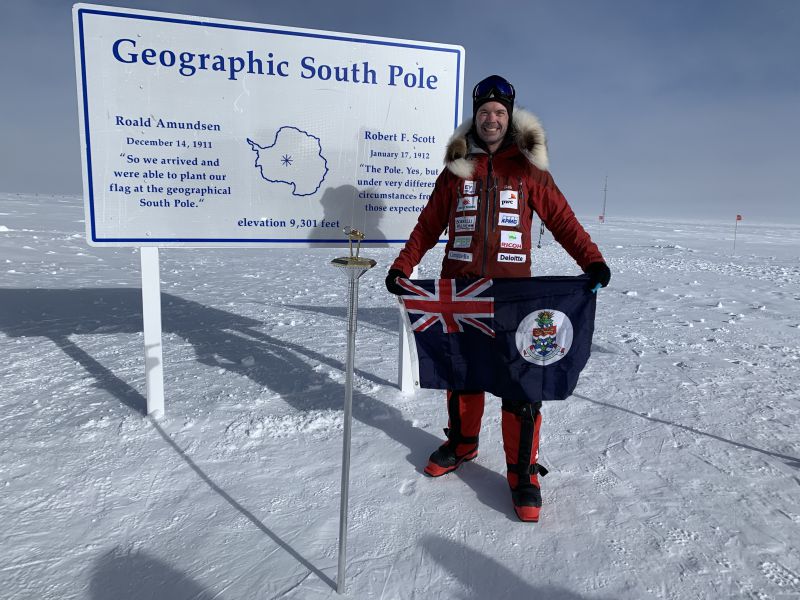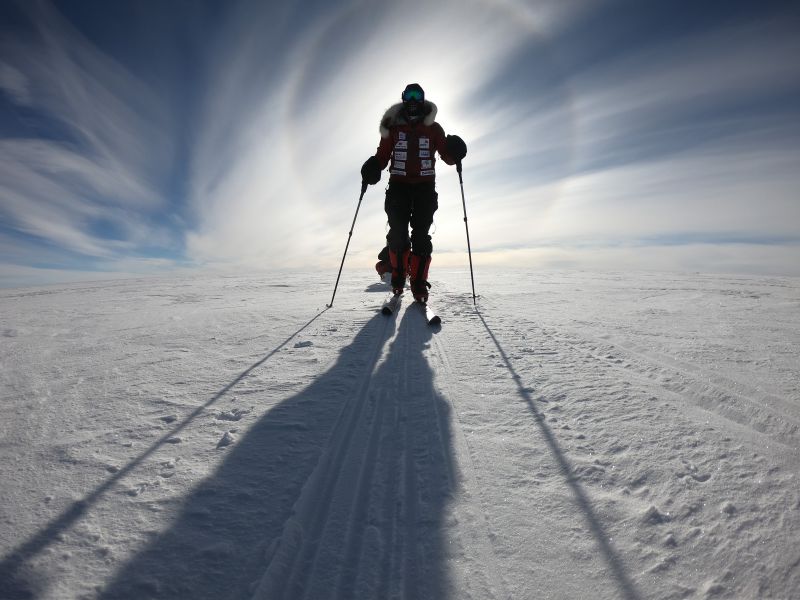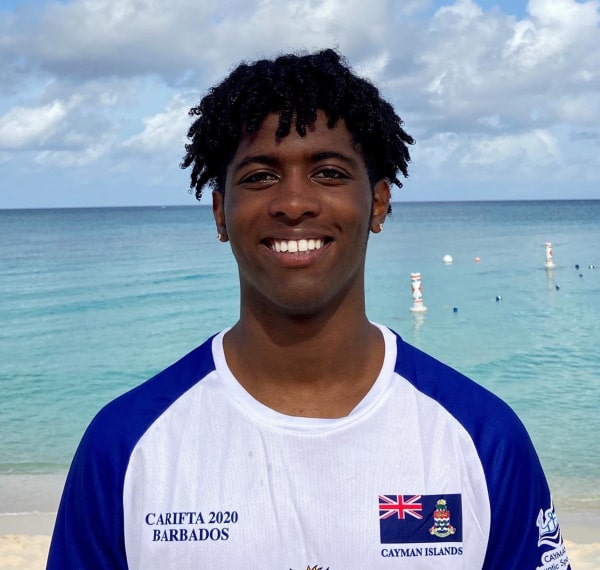(CNS Local Life): The phrase “to the ends of the earth” has real-life meaning for Guy Manning, who recently returned from the absolute bottom, geographically speaking, having trekked to the South Pole. But extremes are nothing new to the Cayman-based lawyer, who has also been to the top of the world – he scaled Mount Everest in 2013 – and plans to make it to the North Pole in 2020.
All of these exploits are in pursuit of the Holy Grail for adventurers – completing the Explorers Grand Slam, which comprises the Seven Summits (the highest mountain peaks on each of the continents, and the North and South Poles. Manning hopes to claim his spot in that exclusive club, which currently has 63 members, next year.
Throughout his adventures he has been fundraising for the Cayman Islands Cancer Society (CICS); his latest trip has brought in just over $71,000 and counting, with $328,000 donated in total. He was inspired to help the Cancer Society after his mother was diagnosed with breast cancer in 2012, leading to a mastectomy. She has been clear of the disease since.
When he reached the summit of Everest he left behind a coded list of the 75 cancer patients in Cayman who were receiving financial aid from CICS; the number has grown to more than 400 now, Manning told CNS Local Life, explaining his commitment to continue to raise money. His dedication led to becoming a member of the society’s board and he has been chairman for the last three years.
Though it may sound counterintuitive, he has mostly trained in Cayman for all these feats, despite the flat terrain and warm weather. Admitting the conditions here have proven a challenge to prepare for the arctic environment of the South Pole, where the temperature hovered at about -40 degrees, he added, “I’d done enough of these cold-weather trips to be ready.” He also did a brief climbing trip to Bolivia in October last year to get in the uphill work.
His focus in Cayman was on strength training, using the SkiErg, a machine that simulates cross-country skiing, which Manning described as a “Mediaeval torture device”. Those hours were well spent, though, since the trek to the South Pole was done on skis, with each member of the originally nine-person team pulling along their own sled carrying supplies and gear that he estimated weighed 100 lbs.
The starting point was at 89 degrees latitude, leaving them to travel that last degree to the pole, or about 69 miles. Unfortunately, the conditions proved too difficult for three of the team, who had to drop out and be evacuated during the trek.
Manning said he never felt he wouldn’t make it, but the cold was still an issue. “There were moments when even with wearing all my clothes, I still felt cold, which was quite concerning.” The group “marched” for 70 minutes six times a day, with a 15-minute break in between, plus a half hour for lunch. Three people each would then set up an emergency shelter to share, basically “a very large nylon bag” to keep out the wind. They each carried a flask of hot water along and could make a cup of instant noodles. “That was fantastic,” he said, “It was the highlight of the day.”
He explained they could not stop for longer because the cold would quickly set in. “I started to dread the breaks. I could stay warm while skiing.” Manning also kept protein bars, nuts and other snacks in his pocket to eat while on the move.
At night they would all pull out tents, food, fuel and stoves that were carried on the sleds. They had to set up camp as quickly as possible because the wind could easily blow away the tents; there were three for sleeping, with three men in each, and one for cooking. Dinner would be eaten seated on two benches dug out of the snow across from each other.
They slept for about six to seven hours a night in -40 degree-rated sleeping bags. Manning said he was “nice and warm” in his sleeping bag. “The only problem was not cold or wind, but one of my tentmates snoring!”
He described the surroundings as “spectacular wilderness. You feel like you are on a different planet. There is no sign of human existence, not a person except for your teammates, no animal life, nothing but ice.”
It was all worth it when after eight days they reached the South Pole on 13 January. “There was an adrenalin rush,” he said. “I was also very aware of the history of the South Pole.” He said he had read about the early explorers, Roald Amundsen and Robert Falcon Scott, who made it to the South Pole in 1911, and Sir Ernest Shackleton, who got close, and had “a real sense of admiration” for them.
“In those days, they had basic equipment and clothing. They were self-reliant, with no communication,” he said, adding that those early explorers then had to go back the way they came, where he and his team were picked up after their one-way trip.
When he stood at the marker indicating the South Pole, he said, “It was an amazing moment. I was at the bottom of the world as far as you can be from civilisation.”
Responding to the possibility that others may think he is crazy for going on these extreme adventures, he said, “People may have a point, but each to his own. I love the challenge, going to wild remote places. For most people it would be a miserable way to spend a holiday.”
And his enthusiasm hasn’t dampened. He hasn’t decided what he will do after he reaches the North Pole next year, but he said, “I doubt I will take a break.”
To support Guy Manning’s fundraising efforts for the Cancer Society go to his Explorers Grand Slam website or drop off a donation directly to the society (call 949-7618)







Glad to see you’re not swimming there yet!
Sincere thank you on behalf of the cancer society and its recipients.
Thank you for sharing! Great discoveries are seldom found by following a beaten path.
Thumbs up!
Congratulations!!